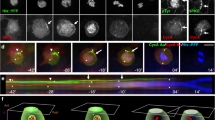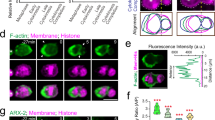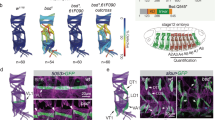Abstract
Ezrin, Radixin and Moesin (ERM) proteins are thought to constitute a bridge between the actin cytoskeleton and the plasma membrane (PM). Here we report a genetic analysis of Dmoesin, the sole member of the ERM family in Drosophila. We show that Dmoesin is required during oogenesis for anchoring microfilaments to the oocyte cortex. Alteration of the actin cytoskeleton resulting from Dmoesin mutations impairs the localization of maternal determinants, thus disrupting antero–posterior polarity. This study also demonstrates the requirement of Dmoesin for the specific organization of cortical microfilaments in nurse cells and, consequently, mutations in Dmoesin produce severe defects in cell shape.
This is a preview of subscription content, access via your institution
Access options
Subscribe to this journal
Receive 12 print issues and online access
$209.00 per year
only $17.42 per issue
Buy this article
- Purchase on SpringerLink
- Instant access to full article PDF
Prices may be subject to local taxes which are calculated during checkout








Similar content being viewed by others
References
Lee, E., Pang, K. & Knecht, D. The regulation of actin polymerization and cross-linking in Dictyostelium. Biochim. Biophys. Acta 1525, 217–227 (2001).
Tsukita, S. & Yonemura, S. Cortical actin organization: lessons from ERM (Ezrin/Radixin/Moesin) proteins. J. Biol. Chem. 274, 34507–34510 (1999).
Mangeat, P., Roy, C. & Martin, M. ERM proteins in cell adhesion and membrane dynamics. Trends Cell Biol. 9, 187–192 (1999).
Bretscher, A., Chambers, D., Nguyen, R. & Reczek, D. Erm-merlin and ebp50 protein families in plasma membrane organization and function. Annu. Rev. Cell Dev. Biol. 16, 113–143 (2000).
Turunen, O., Wahlstrom, T. & Vaheri, A. Ezrin has a COOH-terminal actin-binding site that is conserved in the Ezrin protein family. J. Cell Biol. 126, 1445–1453 (1994).
Tsukita, S., Oishi, K., Sato, N., Sagara, J. & Kawai, A. ERM family members as molecular linkers between the cell surface glycoprotein CD44 and actin-based cytoskeletons. J. Cell Biol. 126, 391–401 (1994).
Denker, S. P., Huang, D. C., Orlowski, J., Furthmayr, H. & Barber, D. L. Direct binding of the Na–H exchanger NHE1 to ERM proteins regulates the cortical cytoskeleton and cell shape independently of H+ translocation. Mol. Cell 6, 1425–1436 (2000).
Chishti, A. H. et al. The FERM domain: a unique module involved in the linkage of cytoplasmic proteins to the membrane. Trends Biochem. Sci. 23, 281–282 (1998).
Pearson, M. A., Reczek, D., Bretscher, A. & Karplus, P. A. Structure of the ERM protein Moesin reveals the FERM domain fold masked by an extended actin binding tail domain. Cell 101, 259–270 (2000).
Ishikawa, H. et al. Structural conversion between open and closed forms of Radixin: low- angle shadowing electron microscopy. J. Mol. Biol. 310, 973–978 (2001).
Nakamura, F., Amieva, M. R. & Furthmayr, H. Phosphorylation of threonine 558 in the carboxyl-terminal actin-binding domain of Moesin by thrombin activation of human platelets. J. Biol. Chem. 270, 31377–31385 (1995).
Takeuchi, K. et al. Perturbation of cell adhesion and microvilli formation by antisense oligonucleotides to ERM family members. J. Cell Biol. 125, 1371–1384 (1994).
Lamb, R. F. et al. Essential functions of Ezrin in maintenance of cell shape and lamellipodial extension in normal and transformed fibroblasts. Curr. Biol. 7, 682–688 (1997).
Doi, Y. et al. Normal development of mice and unimpaired cell adhesion/cell motility/actin-based cytoskeleton without compensatory up-regulation of Ezrin or Radixin in Moesin gene knockout. J. Biol. Chem. 274, 2315–2321 (1999).
McCartney, B. M. & Fehon, R. G. Distinct cellular and subcellular patterns of expression imply distinct functions for the Drosophila homologues of Moesin and the neurofibromatosis 2 tumour suppressor, merlin. J. Cell Biol. 133, 843–852 (1996).
Bourbon, H. M. et al. A P-insertion screen identifying novel X-linked essential genes in Drosophila. Mech. Dev. 110, 71–83 (2002).
van Eeden, F. & St Johnston, D. The polarisation of the anterior–posterior and dorsal–ventral axes during Drosophila oogenesis. Curr. Opin. Genet. Dev. 9, 396–404 (1999).
Baker, N. E. Localization of transcripts from the wingless gene in whole Drosophila embryos. Development 103, 289–298 (1988).
Hay, B., Jan, L. Y. & Jan, Y. N. Localization of Vasa, a component of Drosophila polar granules, in maternal-effect mutants that alter embryonic anteroposterior polarity. Development 109, 425–433 (1990).
Gavis, E. R. & Lehmann, R. Localization of nanos RNA controls embryonic polarity. Cell 71, 301–313 (1992).
Driever, W. & Nusslein-Volhard, C. The bicoid protein determines position in the Drosophila embryo in a concentration-dependent manner. Cell 54, 95–104 (1988).
Ephrussi, A., Dickinson, L. K. & Lehmann, R. Oskar organizes the germ plasm and directs localization of the posterior determinant nanos. Cell 66, 37–50 (1991).
Ephrussi, A. & Lehmann, R. Induction of germ cell formation by oskar. Nature 358, 387–392 (1992).
Kim-Ha, J., Smith, J. L. & Macdonald, P. M. oskar mRNA is localized to the posterior pole of the Drosophila oocyte. Cell 66, 23–35 (1991).
Theurkauf, W. E., Smiley, S., Wong, M. L. & Alberts, B. M. Reorganization of the cytoskeleton during Drosophila oogenesis: implications for axis specification and intercellular transport. Development 115, 923–936 (1992).
Theurkauf, W. E. Premature microtubule-dependent cytoplasmic streaming in cappuccino and spire mutant oocytes. Science 265, 2093–2096 (1994).
Manseau, L., Calley, J. & Phan, H. Profilin is required for posterior patterning of the Drosophila oocyte. Development 122, 2109–2116 (1996).
Clark, I. E., Jan, L. Y. & Jan, Y. N. Reciprocal localization of Nod and kinesin fusion proteins indicates microtubule polarity in the Drosophila oocyte, epithelium, neuron and muscle. Development 124, 461–470 (1997).
Clark, I., Giniger, E., Ruohola-Baker, H., Jan, L. Y. & Jan, Y. N. Transient posterior localization of a kinesin fusion protein reflects anteroposterior polarity of the Drosophila oocyte. Curr. Biol 4, 289–300 (1994).
Brendza, R. P., Serbus, L. R., Duffy, J. B. & Saxton, W. M. A function for kinesin I in the posterior transport of oskar mRNA and Staufen protein. Science 289, 2120–2122 (2000).
Robinson, D. N. & Cooley, L. Genetic analysis of the actin cytoskeleton in the Drosophila ovary. Annu. Rev. Cell Dev. Biol. 13, 147–170 (1997).
MacDougall, N. et al. Merlin, the Drosophila homologue of neurofibromatosis-2, is specifically required in posterior follicle cells for axis formation in the oocyte. Development 128, 665–673 (2001).
Oshiro, N., Fukata, Y. & Kaibuchi, K. Phosphorylation of Moesin by rho-associated kinase (Rho-kinase) plays a crucial role in the formation of microvilli-like structures. J. Biol. Chem. 273, 34663–34666 (1998).
Lantz, V. A., Clemens, S. E. & Miller, K. G. The actin cytoskeleton is required for maintenance of posterior pole plasm components in the Drosophila embryo. Mech. Dev. 85, 111–122 (1999).
Erdelyi, M., Michon, A. M., Guichet, A., Glotzer, J. B. & Ephrussi, A. Requirement for Drosophila cytoplasmic tropomyosin in oskar mRNA localization. Nature 377, 524–527 (1995).
Baum, B., Li, W. & Perrimon, N. A cyclase-associated protein regulates actin and cell polarity during Drosophila oogenesis and in yeast. Curr. Biol. 10, 964–973 (2000).
Verheyen, E. M. & Cooley, L. Profilin mutations disrupt multiple actin-dependent processes during Drosophila development. Development 120, 717–728 (1994).
Matsui, T. et al. Rho-kinase phosphorylates COOH-terminal threonines of Ezrin/Radixin/Moesin (ERM) proteins and regulates their head-to-tail association. J. Cell Biol. 140, 647–657 (1998).
Simons, P. C., Pietromonaco, S. F., Reczek, D., Bretscher, A. & Elias, L. C-terminal threonine phosphorylation activates ERM proteins to link the cell's cortical lipid bilayer to the cytoskeleton. Biochem. Biophys. Res. Commun. 253, 561–565 (1998).
Huang, L., Wong, T. Y., Lin, R. C. & Furthmayr, H. Replacement of threonine 558, a critical site of phosphorylation of Moesin in vivo, with aspartate activates F-actin binding of Moesin. Regulation by conformational change. J. Biol. Chem. 274, 12803–12810 (1999).
Hamada, K., Shimizu, T., Matsui, T., Tsukita, S. & Hakoshima, T. Structural basis of the membrane-targeting and unmasking mechanisms of the Radixin FERM domain. EMBO J. 19, 4449–4462 (2000).
Barret, C., Roy, C., Montcourrier, P., Mangeat, P. & Niggli, V. Mutagenesis of the phosphatidylinositol 4,5-bisphosphate (PIP2) binding site in the NH2-terminal domain of Ezrin correlates with its altered cellular distribution. J. Cell Biol. 151, 1067–1080 (2000).
Gautreau, A., Louvard, D. & Arpin, M. Morphogenic effects of Ezrin require a phosphorylation-induced transition from oligomers to monomers at the plasma membrane. J. Cell Biol. 150, 193–203 (2000).
Edwards, K. A., Demsky, M., Montague, R. A., Weymouth, N. & Kiehart, D. P. GFP–Moesin illuminates actin cytoskeleton dynamics in living tissue and demonstrates cell shape changes during morphogenesis in Drosophila. Dev. Biol. 191, 103–117 (1997).
Payre, F., Vincent, A. & Carreno, S. ovo/svb integrates Wingless and DER pathways to control epidermis differentiation. Nature 400, 271–275 (1999).
Acknowledgements
We thank S. Cohen, N. Dostatni, A. Ephrussi, P. Lasko, P. McDonald, P. Rorth, D. St Johnston, T. Schüpbach and M. van Doren for their generous gifts of biological materials, the Bloomington Stock Center for Drosophila stocks, M.L. Dumont for help with stock keeping, S. Carreno and I. Maridonneau-Parini for their help to C.P., J. Smith, L. Walzer and F. Roch for discussions and comments on the manuscript, and M. Erdélyi for sharing unpublished results and materials. This work was supported by grants from Centre National de la Recherche Scientifique (CNRS), Université Paul Sabatier, Association pour la Recherche sur le Cancer (ARC; subvention number 5116). C.P. and I.D. were supported by Ministère de la Recherche et de l'Education, P.V. was supported by the ARC.
Author information
Authors and Affiliations
Corresponding author
Ethics declarations
Competing interests
The authors declare no competing financial interests.
Supplementary information
Supplementary figure
Figure S1 Cytoplasmic streaming (PDF 115 kb)
Rights and permissions
About this article
Cite this article
Polesello, C., Delon, I., Valenti, P. et al. Dmoesin controls actin-based cell shape and polarity during Drosophila melanogaster oogenesis. Nat Cell Biol 4, 782–789 (2002). https://doi.org/10.1038/ncb856
Received:
Revised:
Accepted:
Published:
Issue Date:
DOI: https://doi.org/10.1038/ncb856
This article is cited by
-
Crumbs, Moesin and Yurt regulate junctional stability and dynamics for a proper morphogenesis of the Drosophila pupal wing epithelium
Scientific Reports (2017)
-
Secretory cells in honeybee hypopharyngeal gland: polarized organization and age-dependent dynamics of plasma membrane
Cell and Tissue Research (2016)
-
A piRNA-like small RNA interacts with and modulates p-ERM proteins in human somatic cells
Nature Communications (2015)
-
Rab11 regulates cell–cell communication during collective cell movements
Nature Cell Biology (2013)
-
Autoantibody biomarkers identified by proteomics methods distinguish ovarian cancer from non-ovarian cancer with various CA-125 levels
Journal of Cancer Research and Clinical Oncology (2013)



